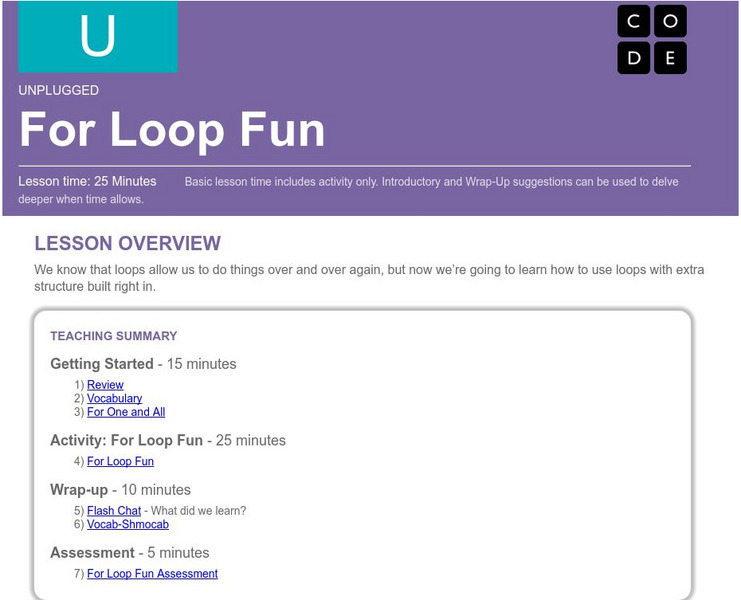Code.org
Minecraft Hour of Code
Devote an hour to computer coding ... it's time well spent! The activity has young computer scientists write code to solve puzzles in the Minecraft game. They learn how to apply block codes and repeat loops.
Google
Music and Sound: Guru Introduction and Musical Talent Show
Become talented in computer science. After interviewing a computer science guru, pupils work on individual projects related to a virtual music talent show. They learn how to use different code blocks in the Scratch programming language,...
Beauty and Joy of Computing
Sprite Drawing and Interaction
Discover how to program objects to move on a screen. In the second lab of a five-part unit, each learner uses block instructions to program a sprite to follow their mouse (cursor). They investigate how to use these same block...
Curated OER
Select a Sound: RCX Programming
Students program an RCX to play one sound if a touch sensor is pressed down and another if it is not pressed. They write the program to repeat twenty times and incorporate the use of both a fork and a loop.
Curated OER
Variable Arrays
Twelfth graders compare and contrast variables and arrays. Using data, they enter the information into a spreadsheet and an array to compare how they appear. To end the lesson, they complete basic programs in which they use arrays.
TryEngineering
Solving a Simple Maze
Solve a maze ... from a robot's point of view. In the lesson, your scholars build a small, simple maze from cardboard and then find a route from the start point to the finish point. They write an algorithmic process that a robot could...
Code.org
Processing Arrays
Scholars use a playing card activity to help them develop a program to find the minimum value of a list. They learn to use for loops to write code that will process lists.
Google
Fashion and Design: Fashion Walk
Strut your stuff, just on a computer and not on a fashion runway. Scholars program a fashion show animation using block-based computer coding. They learn how to apply different code blocks in writing their programs.
Drexel University
Learning Roomba Module 4: Sensors and Actuators
Introduce your classes to sensors and actuators in robots — specifically to the Roomba. Pupils develop programs that make Roomba utilize its different sensors.
EngageNY
The Graph of the Equation y = f(x)
Math language? Set notation is used in mathematics to communicate a process and that the same process can be represented as computer code. The concept to the loop in computer code models the approach pupils take when creating a solution...
Curated OER
GarageBand Orientation
Students create short percussion pieces using the computer program GarageBand. Emphasis is placed on student feedback and discussion after performances of the songs are complete.
Curated OER
Web Design
Students are introduced to the seven web design elements. Using examples, they identify the use of good and bad elements. They work with a computer program to help them design their own website and share them with the class.
Beauty and Joy of Computing
Building Grids for Games
You can't play Tic Tac Toe without grids. In the fourth lab of a five-part unit, scholars learn how to build grids for games such as Tic Tac Toe. Along the way, they also learn about reporter blocks that perform calculations.
Curated OER
Vocabulary Scavenger Hunt
Students define vocabulary words prior to reading "The Most Dangerous Game" in this interactive language arts lesson plan that effectively integrates technology. This lesson plan requires internet access, a mobile computer lab, and an...
Curated OER
Highway Design for the Future
Eighth graders research highway designs and create a marble maze to illustrate a highway system. They test their designs and write reports defining the project and analyzing the results.
Curated OER
Can You Hear a Story?
Students gain an understanding of relationships between music and language arts. They analyze a story and create a musical composition that reflects and enhances the story. The musical accompaniment will be produced in a book on tape.
Curated OER
Graphing Galore!
Students practice sorting and counting different objects. Using this information, they create graphs on a worksheet given to them. They describe and analyze the results and discuss them as a class to end the lesson. They also complete...
Code.org
Code Studio: Computer Programming: Course E
Start coding with algorithms, loops, conditionals, and events and then you'll move on functions. In the second part of this course, design and create a capstone project you can share with your friends and family.
Code.org
Code Studio: Computer Programming: Course F
Learn to use different kinds of loops, events, functions, and conditionals. Investigate different problem-solving techniques and discuss societal impacts of computing and the internet. In the second part of this course, design and create...
Code.org
Code.org: For Loop Fun
We know that loops allow us to do things over and over again, but now we're going to learn how to use loops with extra structure built right in.
Code.org
Code.org: Cs Fundamentals: Lesson 10: Loops With Rey and Bb 8
Building on the concept of repeating instructions from "Getting Loopy," this stage will have students using loops to help BB-8 traverse a maze more efficiently than before.
TeachEngineering
Teach Engineering: Using Waits, Loops and Switches
Students incorporate their knowledge of wait blocks, loops, and switches into their programming of the LEGO MINDSTORMS NXT robots to perform different tasks depending on input from a sound sensor and two touch sensors. This activity...
TeachEngineering
Teach Engineering: How Do You Make Loops and Switches?
Students learn how to program using loops and switches. Using the LEGO MINDSTORMS NXT robots, sensors and software, student pairs perform three mini programming activities using loops and switches individually, and then combined.
Other
Programming Simplified: Java Programs
See some examples made for beginning programmers to understand how to use java to write simple Java programs. These codes demonstrate how to get input from user, working with loops, strings and arrays.






















